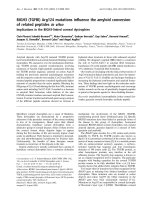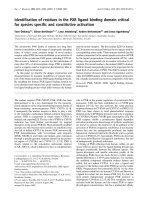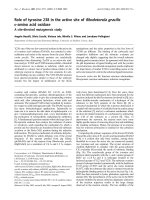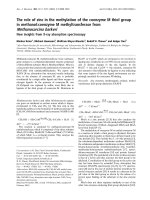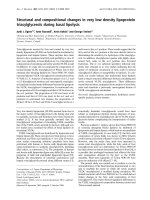Báo cáo y học: "Viruses take center stage in cellular evolution" ppt
Bạn đang xem bản rút gọn của tài liệu. Xem và tải ngay bản đầy đủ của tài liệu tại đây (120.49 KB, 5 trang )
Genome Biology 2006, 7:110
comment
reviews
reports
deposited research
interactions
information
refereed research
Opinion
Viruses take center stage in cellular evolution
Jean-Michel Claverie
Address: Structural and Genomic Information Laboratory, CNRS-UPR2589, IBSM, Parc Scientifique de Luminy, 163 Avenue de Luminy, case
934, Marseille 13288, cedex 9, France. Email:
Published: 16 June 2006
Genome Biology 2006, 7:110 (doi:10.1186/gb-2006-7-6-110)
The electronic version of this article is the complete one and can be
found online at />© 2006 BioMed Central Ltd
The reputedly intractable problem of the origin of viruses
has long been neglected. In the modern literature, ‘virus evo-
lution’ has come to refer to studies more akin to population
genetics, such as the worldwide scrutiny of new polymor-
phisms appearing daily in the H5N1 avian flu virus [1], than
to the fundamental question of where viruses come from.
This is now rapidly changing, as a result of the coincidence
of bold new ideas (and the revival of old ones), the unex-
pected spectacular features of some recently isolated giant
viruses [2,3], as well as the steady increase in the numbers of
genomic sequences for ‘regular’ viruses and cellular organ-
isms, which enhances the power of comparative genomics
[4]. After being considered non-living and relegated to the
wings by most biologists, viruses are now center stage: they
might have been there at the origin of DNA, might have
played a central role in the emergence of the eukaryotic cell,
and might even have been the cause of partitioning of bio-
logical organisms into the three domains of life: Bacteria,
Archaea and Eukarya. In this article, I shall briefly survey
some of the recent discoveries and the new evolutionary
thoughts they have prompted, before adding to the discus-
sion with a question of my own: what if we have totally
missed the true nature of (at least some) viruses?
Ancient viruses as the origin of different
domains
As of April 2006, more than 1,600 viral genomes have been
sequenced, approximately equally divided between RNA and
DNA viruses. In view of this fundamental difference in their
genetic material (and thus in their replication mechanisms,
size, genetic complexity, host range and other features) it is
tempting to immediately rule out the idea that viruses are
monophyletic, that is, that they derive from a common
ancestor. That might not be so easy to do, however. Although
there are many arguments in favor of the idea that RNA and
DNA viruses were generated independently - RNA viruses
first, in the context of the ‘RNA world’ theory - their genesis
might have overlapped quite significantly either before or
shortly after the Last Universal Common Ancestor (LUCA,
the last unique ancestor of all cellular life, reviewed in [2]),
allowing a non-negligible level of genome mixing. Indeed,
several proteins have homologs in both RNA and DNA
viruses, the most important of all being the jelly-roll capsid
protein [5], the sole protein that is found in most viruses and
not found in cellular organisms [6]. Other components are
shared between the two types of viruses, but these are con-
sidered to be the results of more recent lateral gene trans-
fers; they include the chaperonin Hsp70, which is found in
the giant double-stranded DNA (dsDNA) mimivirus [7] and
the positive-strand RNA closteroviruses [8].
The notion that viruses might be very ancient (and even
ancestral to cells, as proposed by d’Herelle, the discoverer of
bacteriophages [9]) has become the starting point of increas-
ingly daring evolutionary scenarios, modernized to take into
account our present knowledge of molecular biology and
genomics [10,11]. To explain the puzzling phylogenies and
distribution of many DNA informational proteins (proteins
involved in the replication and transcription of DNA)
Abstract
The origins of viruses are shrouded in mystery, but advances in genomics and the discovery of
highly complex giant DNA viruses have stimulated new hypotheses that DNA viruses were involved
in the emergence of the eukaryotic cell nucleus, and that they are worthy of being considered as
living organisms.
between the three domains of life, it has been proposed that
DNA viruses could be the origin of present-day eukaryotic
replication proteins [12,13]. Other researchers postulate that
a large poxvirus-like dsDNA virus might be the origin of the
eukaryotic nucleus, taken in by an ancestral cell and adapted
as an organelle - the notion of viral eukaryogenesis [14,15]. I
personally find the general idea that a nucleus is functionally
equivalent to a selfish DNA virus (that is, replicating ‘its’ DNA
using the cellular metabolism) simple and very appealing -
and even more so when one realizes that the idea can be
turned on its head to envisage the nucleus of a (primitive)
eukaryote (re-)turning into a large DNA virus - the notion of
nuclear viriogenesis (Figure 1). Of particular interest, such a
transfer of an ‘infectious’ nucleus is well documented in many
parasitic red algae [16].
Such back-and-forth eukaryogenesis-viriogenesis could
readily explain the multiplicity of present-day virus lineages,
together with their diversity in size, complexity and gene
complement, as well as the apparent mixture of monophyly
and polyphyly (descent from more than one ancestor) exhib-
ited by the viral world. In this context, extant complex
eukaryotic DNA viruses could have originated from iterative
waves of nuclear viriogenesis. But we still need some initial
‘seeding’ virus, the one that, for instance, invented the proto-
type of the now nearly ubiquitous jelly-roll capsid protein.
Reviving d’Herelle’s initial ‘virus first’ hypothesis, Koonin
and Martin [17] paradoxically proposed that RNA viruses
might have emerged even before the invention of individual
cells, as selfish RNA replicons roaming prebiotic inorganic
compartments. There is little chance, however, that this
hypothesis could be scientifically proven anytime soon.
Also quite provocative is the idea that RNA viruses might be
at the origin of DNA biochemistry [2,18]. According to this
scenario, RNA-based viruses infecting RNA-based cells
would have acquired an RNA-to-DNA modification system
to resist cellular RNA-degrading enzymes (the RNA equiva-
lent of present-day bacterial restriction and modification
systems). For this to happen, RNA viruses would have had to
evolve the ribonucleotide reductase enzyme, to convert
diphosphate-ribonucleotides to diphosphate-deoxyribonu-
cleotides, and thymidylate synthase, to make dTMP from
dUMP, the two key pathways in DNA synthesis. Cellular
RNA was then replaced by DNA in the course of evolution
because of its greater stability and the capacity for repair
conferred by its double-stranded structure, allowing larger,
more complex genomes to out-compete the RNA-based
genomes of more primitive cells [18]. Note that this scenario
is nicely complementary to the viral eukaryogenesis hypoth-
esis, the cellular RNA genes being progressively recruited
within the newly acquired DNA-based ‘nucleus’ (see Figure
1). Interestingly, deoxyuridine is known to replace thymidine
in the DNA of several bacteriophages [19].
110.2 Genome Biology 2006, Volume 7, Issue 6, Article 110 Claverie />Genome Biology 2006, 7:110
Figure 1
A possible iterative scenario for viral eukaryogenesis and nuclear viriogenesis. (a) A primitive DNA virus (a bacteriophage ancestor) gets trapped within
an RNA cell and becomes a primitive nucleus. (b) Cellular genes are progressively recruited to the enlarging nucleus because of the selective advantages
of DNA biochemistry. (c) For a while this situation remains unstable and reversible, allowing new ‘pre-eukaryotic viruses’ to be created. These viruses
reinfect other cells at various stages of this iterative process. (d) This hypothetical scheme provides a mechanism for the emergence of various
overlapping but not monophyletic virus lineages as well as for the rapid reassortment of genes from the viral and cellular pools before they reach their
‘Darwinian threshold’ [29], that is, (e) the evolution of a stable eukaryotic cell with a fully DNA nuclear genome.
Different DNA virus lineages
(different assortments of cellular and viral genes)
Primitive eukaryotic
DNA cell
Nuclear
viriogenesis
Viral
eukaryogenesis
Initial DNA virus
RNA cell
RNA cell → DNA cell
(b) (c) (e)
(d)
(a)
Finally, in a paper that has already received much attention,
Forterre [20] promoted (ancient) viruses to another funda-
mental role: to have been at the origin of the three basic cel-
lular domains. His ‘three RNA cells, three DNA viruses’
hypothesis explains firstly, why there are three discrete lin-
eages of modern cells instead of a continuum; secondly, the
existence of three canonical ribosomal patterns; and thirdly,
the critical differences exhibited by the, nevertheless similar,
eukaryotic and archaeal replication machineries. This is
readily done by postulating that DNA technology was inde-
pendently transferred by three different founder DNA
viruses to RNA-based ancestors of the Archaea, Bacteria,
and Eukarya respectively. The reduction in rates of evolution
following the transition from an RNA to a DNA genome
would have stabilized the three canonical versions of transla-
tion proteins that are still recognizable today.
Traditional ‘cell-first’ hypotheses
If, for a moment, we put aside the paradoxical virus-first
hypothesis, we are left with two more traditional (cell-first)
hypotheses about the origin of viruses in general. One is the
‘escape hypothesis’, which views viruses as originating from
cells by the escape of a minimal set of cellular components
necessary to constitute an infectious selfish replicating
system. The other is the ‘reduction hypothesis’, in which
viruses would have derived from a cellular organism through
a progressive loss of functions until it finally became a bona
fide virus. In real life, unfortunately, this simple dichotomy
will be blurred by the accretion of genes laterally transferred
between viruses (or parasitic cellular organisms) sharing
identical hosts, or directly captured from the virus hosts. In
that respect, bacteriophages differ markedly from most
eukaryotic dsDNA viruses by exhibiting massive recombina-
tional reassortment and accretion of genes, most probably
resulting from the existence of a prophage state integrated
into the host genome [21]. Yet 80% of the genes of dsDNA
bacteriophages have no obvious homologs in microbial
genomes, suggesting a large degree of evolutionary indepen-
dence of the phage gene set [22]. A much stricter genetic iso-
lation is exhibited by the eukaryotic nucleocytoplasmic large
dsDNA viruses (NCLDV), such as the giant Acanthamoeba
polyphaga mimivirus [7], whose 1.2 Mb genome (911 genes)
exhibits little evidence of horizontal transfer [23]. This also
holds true for the next-largest NCLDVs, alga-infecting phy-
codnaviruses (with known genome sequences in the 300-
400 kb range) [24,25]. Mimivirus also exhibits a high level
of genomic coherence, as shown by the homogeneity of its
nucleotide composition and the strict conservation of half of
its promoter sequences [26].
As more genomes of large eukaryotic viruses are sequenced,
new genes keep turning up, most of them with no obvious
phylogenetic affinity with known hosts or extant cellular
organisms. This simple observation is definitely more favor-
able to the idea that these large viruses arose from the
reduction of a more complex ancestral (viral) genome, than
to the hypothetical accretion of numerous exogenous genes
(without recognizable origin) around a primitive minimal
viral genome. Recent results on coccolithovirus EhV-86
illustrate this point very nicely. Until the 407 kb genome of
EhV-86 was characterized, the trademark of all previously
characterized phycodnaviruses (with smaller 320 kb
genomes) compared with other NCLDVs was the absence of
a virus-encoded transcription machinery (a lack of DNA-
directed RNA polymerase) [24]. Obviously, the presence or
absence of an RNA polymerase implies major differences in
virus physiology. Unexpectedly, EhV-86 was found to
encode its own six-subunit transcriptional machinery [25].
Nevertheless, a phylogenetic analysis of 25 core genes
common to NCLDVs firmly placed EhV-86 within the Phy-
codnaviridae clade [25]. In this case, the loss of the tran-
scription apparatus by the smaller phycodnaviruses, rather
than the simultaneous gain of the six subunits of an RNA
polymerase by EhV-86, appears much more likely.
The reduction hypothesis received a strong boost from the
discovery and genomic characterization of A. polyphaga
mimivirus [7], the first virus to largely overlap with the
world of cellular organisms, in terms of both particle size
and genome complexity [2]. The finding of numerous virally
encoded components of an incomplete translation apparatus
strongly suggested a process of reductive evolution from an
even more complex ancestor that was endowed with protein
synthetic capability. Such an ancestor could either have
evolved from an obligate intracellular parasitic cell (func-
tionally similar to Rickettsia or Chlamydia), or be derived
from the nucleus of a primitive eukaryote through the mech-
anism illustrated in Figure 1. If reduction is the scenario at
the origin of mimivirus, it is most likely to apply to other
NCLDVs, in particular to those exhibiting the closest phylo-
genetic affinity with mimivirus such as the Phycodnaviridae
and Iridoviridae. Sequencing additional large genomes from
representatives of these families should provide valuable
insights about this postulated giant ancestor.
Changing the viewpoint on viruses
At first sight, bacterial obligate intracellular parasites such
as Rickettsia and Chlamydia have little functional resem-
blance to mimivirus despite a comparable genomic complex-
ity. On one side, the bacteria are metabolically active,
stealing ATP and biochemical precursors from their hosts to
transcribe their genomes, translate their proteins, replicate
their DNA, and divide. On the other side, one sees a large but
metabolically silent viral particle, not deserving to be
described as living by most biologists. This traditional view
might, however, be a case of ‘when the finger points to the
stars, the fool looks at the finger’. Rather than comparing a
parasitic cell to the virus particle, I believe we should
compare it to the ‘virus factory’ [27]. Not much is yet known
specifically on mimivirus factories, but upon infection, all
comment
reviews
reports
deposited research
interactions
information
refereed research
Genome Biology 2006, Volume 7, Issue 6, Article 110 Claverie 110.3
Genome Biology 2006, 7:110
complex eukaryotic viruses such as iridoviruses, poxviruses,
and asfarviruses give rise to complex intracellular structures
that transcribe the viral genome, translate transcripts into
proteins, and replicate the viral DNA, before packaging it
into sophisticated vehicles designed to reproduce the virus
factory upon the infection of another host cell (Figure 2).
The virus factory is enclosed by a membrane (often derived
from the rough endoplasmic reticulum) to exclude cellular
organelles, but contains ribosomes and cytoskeletal ele-
ments. In the meantime, the virus factory recruits the mito-
chondria at its periphery, from which it obtains ATP [27]. At
this stage, the overall functional resemblance between an
intracellular parasitic bacterium and a large eukaryotic virus
is quite striking. From this point of view, the genomic com-
plexity of NCLDVs is no longer paradoxical, as it is commen-
surate with the complexity of the cell-like virus factory, but
not with the particle used to reproduce it. Interpreting the
virion particle as ‘the virus’, is very much like looking at a
spermatozoid and calling it a human: a 3,000 Mb genome
would seem like overkill for such a unicellular organism (the
similar thought arises when considering the size of plant
genomes when looking at metabolically inert pollen grains).
Conceptually, the analogy between a virus life cycle and the
reproductive cycle of a nondividing organism can be
extended further. Sensu August Weismann, the virus particle
possesses all the property of the Germen (the germline, the
continuous immortal lineage responsible for carrying one
generation to the next), whereas the transient virus factory
exhibits all the property of the Soma, the body or somatic
cells [28]. Also, according to Weismann, such a partition
implies the phenomenon of aging: once the opportunity to
pass germplasm on has passed (that is, once viral particles
have been produced), there is no need to maintain the
integrity of the somaplasm. In this interpretation, the virus
factory now becomes the ultimate illustration of a disposable
soma, vanishing immediately after viral particles have been
produced. Nevertheless, I believe that the virus factory
should be considered the actual virus organism when refer-
ring to a virus. Incidentally, in this interpretation the living
nature of viruses is undisputable, on the same footing as
intracellular bacterial parasites. Focusing on the structure of
the virus factory rather than on the morphology of the virus
particle might help us reach a better understanding of the
evolutionary history of viruses.
A serious difficulty in the reductive hypothesis for the origin
of viruses (when considered as particles) is to propose rea-
sonable mechanisms by which a cell, even a highly parasitic
cell, might switch from a cellular dividing mode to a host-
supported particle-replication mode all at once. Focusing on
viruses as cell-like factories rather than particles makes it
much easier to conceive a gradual transition. I would like to
propose the following scenario. The event committing a par-
asitic cell towards the reductive viral evolution pathway
would be the loss of an essential component of its translation
apparatus (for example, a ribosomal protein): the presence
or absence of an encoded protein synthesis system clearly
remains the last unambiguous genomic divide between the
viral and the cellular worlds. In order to survive, the now
translation-defective cell would have had to adopt new
strategies to gain access to the ribosomes of its hosts. At the
same time, this translation-defective cell could now dispense
with the rest of its ribosome-encoding genes. Such an inter-
mediate protoviral cell could survive in its original host
while improving the design of a bona fide virus factory.
Finally, a gamete-like genome-packaging process could
emerge, following the acquisition of a capsid protein gene
from an ancestral RNA virus. Such an event would allow the
reduced cellular genome to be reproduced in many more
copies, at the same time relieving the burden of maintaining
the viability of the infected host cells. The soma-like virus
factory could then become the transient organism we
observe today.
110.4 Genome Biology 2006, Volume 7, Issue 6, Article 110 Claverie />Genome Biology 2006, 7:110
Figure 2
What is a virus? The life cycle of a complex dsDNA virus (for example
NCLDVs) is shown. (a) A virus particle infects the cell and releases its
DNA into the cytoplasm. (b) The viral DNA replicates and capsid
proteins are synthesized within a ‘virus factory’ in the cytoplasm to which
are recruited cellular ribosomes and the protein-synthesis machinery, as
well as mitochondria to provide ATP. (c) New infectious viral particles
are produced (while the nucleus is fading) and (d) released from the cell
to begin another round of infection and replication. I propose that the
true nature of complex eukaryotic dsDNA viruses is found in the
transient virus factory they produce at each generation, rather than in the
reproductive virus particle with which they have been equated. The virus
factory is proposed to represent the result of the progressive reductive
evolution of an obligate parasitic cellular organism, committed to the viral
evolutionary pathway by the loss of a functional translation machinery.
For a viral organism, the virus factory exhibits all the properties of the
soma, in which genes are expressed, while the particle state corresponds
to the germline (sensu August Weismann [28]) which remains unchanged.
If we follow this line of thought, one might think of infection as being
analogous with fertilization and the production of new virus particles as
being akin to the formation of gametes.
Germline
(No gene
expression)
‘Gamete’ genesis
(Production of virus particles)
Viral
capsids
Free virus
particles
New virus
particles
(d)
(a)
(b)
(c)
‘Fertilization’
(infection)
Cell
nucleus
‘Soma’
(Gene expression)
Virus factory
(cell-like organism)
Mitochondrion
In summary, the past few years have seen a spectacular
renaissance of the field of viral evolution, prompted equally
by the publication of increasing bold theories on the origin of
life, the realization that viruses are the dominant life form on
Earth, an exponential increase of genomic data, and the
serendipitous discovery of few giant viruses. Viruses have
come a long way from being unwanted inhabitants of the
Tree of Life, to being given a central role in all major evolu-
tionary transitions [6]. The challenge is now to unify the
many evolutionary scenarios that have been proposed, using
hard facts and experimental data, without getting side-
tracked by the many spectacular but anecdotal features that
individual virus families have incorporated during their long
and probably chaotic history.
References
1. Ghedin E, Sengamalay NA, Shumway M, Zaborsky J, Feldblyum T,
Subbu V, Spiro DJ, Sitz J, Koo H, Bolotov P, et al.: Large-scale
sequencing of human influenza reveals the dynamic nature
of viral genome evolution. Nature 2005, 437:1162-1166.
2. Claverie JM, Ogata H, Audic S, Abergel C, Suhre K, Fournier PE:
Mimivirus and the emerging concept of “giant” virus. Virus
Res 2006, 117:133-144.
3. GiantVirus.org [www.giantvirus.org]
4. Koonin EV, Dolja VV: Evolution of complexity in the viral
world: the dawn of a new vision. Virus Res 2006, 117:1-4.
5. Bamford DH, Grimes JM, Stuart DI: What does structure tell us
about virus evolution? Curr Opin Struct Biol 2005, 15:655-663.
6. Forterre P: The origin of viruses and their possible roles in
major evolutionary transitions. Virus Res 2006, 117:5-16
7. Raoult D, Audic S, Robert C, Abergel C, Renesto P, Ogata H, La
Scola B, Suzan M, Claverie JM: The 1.2-megabase genome
sequence of Mimivirus. Science 2004, 306:1344-1350.
8. Dolja VV, Kreuze JF, Valkonen JP: Comparative and functional
genomics of closteroviruses. Virus Res 2006, 117:38-51.
9. D’Herelle F: The Bacteriophage; Its Role in Immunity. Baltimore:
Williams and Wilkins; 1922.
10. Bamford DH: Do virus form lineages across different domain
of life? Res Microbiol 2003, 154:231-236.
11. Forterre P: The great virus comeback: from an evolutionary
perspective. Res Microbiol 2003, 154:223-225.
12. Villarreal LP, DeFilippis VR: A hypothesis for DNA viruses as
the origin of eukaryotic replication proteins. J Virol 2000,
74:7079-7084.
13. Forterre P: Displacement of cellular proteins by functional
analogues from plasmids or viruses could explain puzzling
phylogenies of many DNA informational proteins. Mol Micro-
biol 1999, 33:457-465.
14. Takemura M: Poxviruses and the origin of the eukaryotic
nucleus. J Mol Evol 2001, 52:419-425.
15. Bell PJ: Viral eukaryogenesis: was the ancestor of the nucleus
a complex DNA virus? J Mol Evol 2001, 53:251-256.
16. Goff LJ, Coleman AW: Fate of parasite and host organelle
DNA during cellular transformation of red algae by their
parasites. Plant Cell 1995, 7:1899-1911.
17. Koonin EV, Martin W: On the origin of genomes and cells
within inorganic compartments. Trends Genet 2005, 21:647-654.
18. Forterre P: The origin of DNA genomes and DNA replication
proteins. Curr Opin Microbiol 2002, 5:525-532.
19. Takahashi I, Marmur J: Replacement of thymidylic acid by
deoxyuridylic acid in the deoxyribonucleic acid of a trans-
ducing phage for Bacillus subtilis. Nature 1963, 197:794-795.
20. Forterre P: Three RNA cells for ribosomal lineages and three
DNA viruses to replicate their genomes: a hypothesis for
the origin of cellular domain. Proc Natl Acad Sci USA 2006,
103:3669-3674.
21. Hendrix RW, Lawrence JG, Hatfull GF, Casjens S: The origin and
ongoing evolution of viruses. Trends Microbiol 2000, 8:504-508.
22. Liu J, Glazko G, Mushegian A: Protein repertoire of double-
stranded bacteriophages. Virus Res 2006, 117:68-80.
23. Ogata H, Abergel C, Raoult D, Claverie JM: Response to
Comment on “The 1.2-megabase genome sequence of
Mimivirus”. Science 2005, 308:1114.
24. Dunigan DD, Fitzgerald LA, Van Etten JL: Phycodnaviruses: A
peek at genetic diversity. Virus Res 2006, 117:119-132.
25. Wilson WH, Schroeder DC, Allen MJ, Holden MT, Parkhill J, Barrell
BG, Churcher C, Hamlin N, Mungall K, Norbertczak H, et al.: Com-
plete genome sequence and lytic phase transcription profile
of a Coccolithovirus. Science 2005, 309:1090-1092.
26. Suhre K, Audic S, Claverie JM: Mimivirus gene promoters
exhibit an unprecedented conservation among all eukary-
otes. Proc Natl Acad Sci USA 2005, 102:14689-14693.
27. Novoa RR, Calderita G, Arranz R, Fontana J, Granzow H, Risco C:
Virus factories: associations of cell organelles for viral repli-
cation and morphogenesis. Biol Cell 2005, 97:147-172.
28. Weismann A: Essays upon Heredity and Kindred Biological Problems.
Oxford: Clarendon Press, 1889.
29. Woese CR: On the evolution of cells. Proc Natl Acad Sci USA
2002, 99:8742-8747.
comment
reviews
reports
deposited research
interactions
information
refereed research
Genome Biology 2006, Volume 7, Issue 6, Article 110 Claverie 110.5
Genome Biology 2006, 7:110
